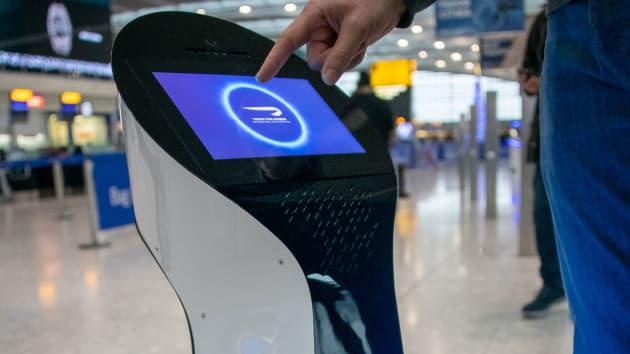Published Sat, Jan 11 202010:31 AM EST Tim Hornyak@robotopia
- Robots are staffing airports around the world and performing such tasks as check-in, security and concierge services.
- Nearly half of the world’s airlines and 32% of its airports are seeking a partner to further investigate robotics and automated vehicles in the next three years, according to the 2018 Air Transport IT Insights survey.
- By 2030 robots are expected to have replaced check-in processes, according to a report published this year by UK-based inventory management company Vero Solutions.
“Good morning. Welcome to British Airways. Where can I take you?” The crisp female voice might belong to any woman working for BA, but it’s a robot cruising around London’s Heathrow Airport. The carrier is trying out a pair of autonomous robots that can guide passengers around Terminal 5. It’s one of the latest examples of increasing automation at airports including advanced intelligent machines that interact with passengers.
Terminal 5 is Heathrow’s busiest, with some 32.8 million passengers on 210,723 flights in 2018. The following year, BA installed 80 automated bag-drop machines in the facility; it also has experimented with self-driving luggage vehicles. The carrier says automation in the terminal has reduced the number of lineups and made journeys faster and smoother.
To make the new robots more user-friendly, they’ve both been named Bill after Captain E. H. “Bill” Lawford, who flew the U.K.’s first international scheduled passenger flight, from Middlesex to Paris, in 1919.
“We are always looking for new and innovative ways to use automation to help our customers enjoy a faster and smoother journey through the airport and beyond,” says Ricardo Vidal, head of innovation at BA. “These smart robots are the latest innovation allowing us to free up our people to deal with immediate issues and offer that one-on-one service we know our customers appreciate. In the future, I envisage a fleet of robots working side-by-side with our people, offering a truly seamless travel experience.”

Robots at Heathrow Airport can communicate with passengers in multiple languages and can provide real-time flight information.
The pair of waist-high robots from London-based BotsAndUs can communicate with passengers in multiple languages and can provide real-time flight information. They can also guide people to service desks, oversized luggage check-in counters, self-service check-ins, bag drops, cafes and other facilities in the terminal. The machines are based on the company’s Bo robot, which has an 11-inch display and sensors including 3D LIDAR, ultrasonic, infrared and vision. It can autonomously navigate and avoid obstacles and has a lithium-ion battery with eight hours of power on a full charge.
“Automation has already significantly changed how airports function, across all areas of operation — from passenger services to luggage maneuvering, security and many more,” says Andrei Danescu, co-founder and CEO of BotsAndUs. “What we see as a key next step is actually bringing all these together so they can communicate and collaborate with each other, offering a seamless and safe experience from the car park to boarding the flight.”
Worldwide rollout
Heathrow isn’t the only airport trying to roll out robots. They’ve appeared at airports in places like LaGuardia, Munich and Seoul. Robots or autonomous machines are part of pilot projects at 40% of airlines and make up major programs at 14% of carriers, according to the 2019 Air Transport IT Insights survey, published by industry association SITA. It reported in 2018 that nearly half the world’s airlines and almost a third of airports want to investigate robotics and automa

Robots at Heathrow Airport can communicate with passengers in multiple languages and can provide real-time flight information.
The pair of waist-high robots from London-based BotsAndUs can communicate with passengers in multiple languages and can provide real-time flight information. They can also guide people to service desks, oversized luggage check-in counters, self-service check-ins, bag drops, cafes and other facilities in the terminal. The machines are based on the company’s Bo robot, which has an 11-inch display and sensors including 3D LIDAR, ultrasonic, infrared and vision. It can autonomously navigate and avoid obstacles and has a lithium-ion battery with eight hours of power on a full charge.
“Automation has already significantly changed how airports function, across all areas of operation — from passenger services to luggage maneuvering, security and many more,” says Andrei Danescu, co-founder and CEO of BotsAndUs. “What we see as a key next step is actually bringing all these together so they can communicate and collaborate with each other, offering a seamless and safe experience from the car park to boarding the flight.”
Worldwide rollout
Heathrow isn’t the only airport trying to roll out robots. They’ve appeared at airports in places like LaGuardia, Munich and Seoul. Robots or autonomous machines are part of pilot projects at 40% of airlines and make up major programs at 14% of carriers, according to the 2019 Air Transport IT Insights survey, published by industry association SITA. It reported in 2018 that nearly half the world’s airlines and almost a third of airports want to investigate robotics and automated vehicles in the next three years. Industry players are trying out various kinds of machines that serve different purposes.
read more at : https://www.cnbc.com/2020/01/10/meet-the-robots-that-may-be-coming-to-an-airport-near-you.html

